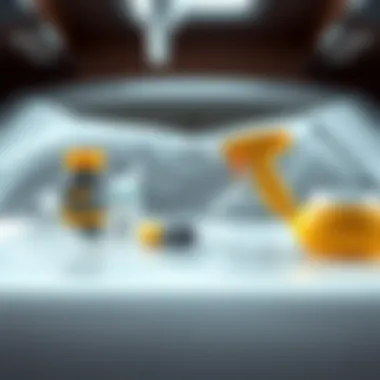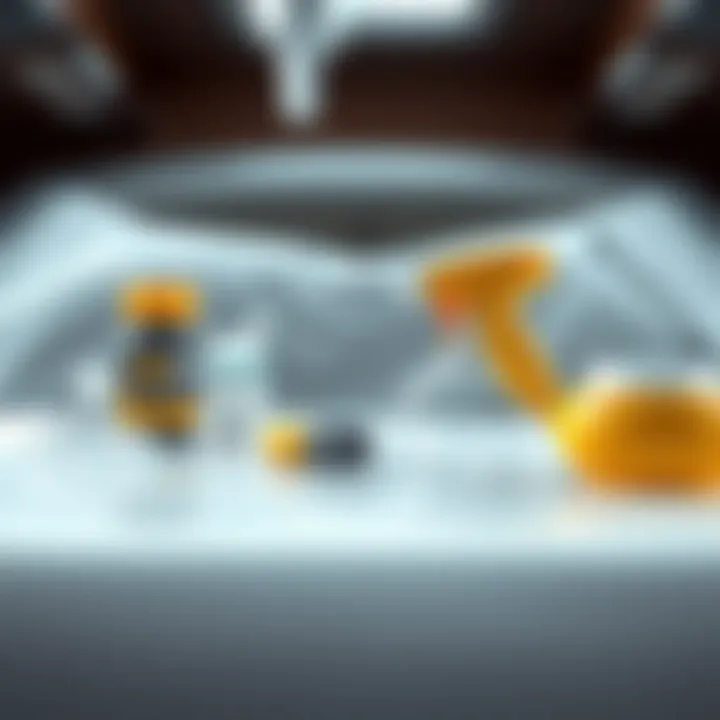Sanitize Your RV Fresh Water Tank Effectively


Intro
When it comes to enjoying the open roads in your RV, the last thing you want is to compromise your health through contaminated water. Maintaining a clean and safe fresh water tank is paramount for any RV owner. Not only does proper sanitation ensure safe drinking water, but it also extends the life of your plumbing system. In this guide, we will dissect effective methods for sanitizing your RV fresh water tank, bringing forth practical steps and useful insights that can keep your water supply as fresh as a daisy.
The journey to cleanliness begins with understanding the importance of sanitization. Many RV enthusiasts may not realize how a small oversight can lead to significant issues. Whether it's the odd traveler on the road or a few months of inactivity, bacteria and other contaminants can quickly multiply. By focusing on effective sanitation methods, this article seeks to provide RV owners with the tools they need to make informed decisions about their water supply.
Through a consistent approach combining routine maintenance and specific sanitization techniques, RV owners can maintain a high standard of hygiene and quality in their fresh water systems. Let’s dive in and uncover the methods that will ensure a safe and refreshed water experience while you’re on the move.
Prolusion to RV Fresh Water Systems
Understanding your RV's fresh water system is like knowing the veins in your body; it's essential for maintaining a healthy environment in your recreational vehicle. The fresh water system is a complex ensemble that transforms stored water into clean, drinkable liquid, crucial for cooking, bathing, and cleaning. Unlike those stationary homes, RVs have the unique challenge of portability, which leads to distinct factors associated with their water tanks. For instance, the tank may face variations in temperature, exposure to debris, or difficulty in drainage— all of which can impact water quality.
Imagine cruising through the mountains or along sun-kissed beaches with your friends or family, expecting nothing less than refreshing water to accompany your adventures. But if your tank isn’t up to par, it might just turn into a challenge instead of an enjoyment. Regular inspections and upkeep of the fresh water system are not just smart practices but also a safety measure. After all, your health and comfort hinge on that simple system you often take for granted.
The beauty of RV systems lies in their integration. A single uninterrupted system handles storage, distribution, and in some cases, even filtration. This interconnected web becomes a haven for bacteria and other contaminants if neglected. Therefore, an understanding of this system can lead you to make informed choices about sanitization practices. Familiarity with components like hoses, pumps, filters, and heat exchangers helps in grasping how to maintain water cleanliness.
In this section of the article, we’ll explore the intricacies of these systems in detail, as well as the profound implications they have on your camping experiences and overall health. Remember, being proactive is always better than being reactive; thus, investing time in knowing your RV’s fresh water system could save a lot of headaches down the road.
Understanding the Importance of Water Tank Sanitization
When it comes to RV ownership, few aspects command as much attention as ensuring hte water you consume and use is clean and safe. A sanitized fresh water tank is not just a suggestion; it’s a necessity. Understanding the importance of water tank sanitization allows you to safeguard your health, enhance your RV's longevity, and ensure that your travels are enjoyable and stress-free.
To dig deeper, let’s consider the repercussions of neglecting water tank sanitization. Over time, bacteria, algae, and sediment can accumulate in your tank, turning a once-pristine water source into a breeding ground for contaminants. This isn't just about taste or odor; it’s about your well-being. Regular sanitization of your water tank can significantly reduce the risk of gastrointestinal illnesses caused by harmful pathogens.
Key Benefits of Sanitizing Your Water Tank
- Health Protection: By eliminating harmful microorganisms, you reduce the chance of waterborne diseases.
- Taste Improvement: Clean water does wonders for flavor, which is important whether you're making coffee or cooking a meal.
- Preservation of Equipment: A clean tank helps maintain the integrity of pipes and pumps, potentially extending the lifespan of your RV's water system.
Considerations to Keep in Mind
It’s essential to approach the sanitization process with a strategic mindset. Using the right sanitizing solutions, the correct concentration, and the appropriate method can make all the difference. Chlorine bleach and hydrogen peroxide can be effective, but they need to be used with care. Too much of a good thing can turn sour, so understanding the proper dilution ratios ensures safety.
Additionally, the frequency of sanitization plays a critical role. It's recommended to undertake this process at least twice a year or after lengthy periods of inactivity. When you’re catching up on seasonal maintenance, don’t let your water tank slip through the cracks.
"Sanitization is not just cleaning; it's a practice that preserves life and pleasure on the road."
For further insights on RV maintenance, you might find these sources helpful:
Signs of a Contaminated Fresh Water Tank
In an RV, the fresh water tank serves as a lifeline, providing water for drinking, cooking, and personal hygiene. However, it's not impervious to contamination, and recognizing the signs of such issues is paramount. Spotting these indicators early can prevent health risks and costly repairs down the line. Let's delve into the distinct signs that signal a contaminated fresh water tank, ensuring you stay informed and your water remains safe.
Unpleasant Odors
One of the first red flags that something is off with your fresh water tank is an unpleasant odor. If your water smells musty or like rotten eggs, this could indicate the presence of bacteria or sulfonated gases, which can emanate from stagnant water or biofilm buildup. It's essential to trust your nose here; just one whiff can tell you that something isn't right.
Regularly checking for odors can save you not only from health hazards but also from extensive cleaning efforts later.
Discoloration
Discoloration of water is another clear sign of a problem. When the water from your tank comes out tinted or murky, it's like waving a neon flag that reads "contamination ahead!" Rust from aging pipes, sediment buildup, or even algae growth can cause changes in color. Each type of discoloration can signal different issues, but any deviation from clear, clean water should prompt further action.
Unusual Taste
We often say "you are what you eat", but in the context of RV water systems, the mantra can extend to your water. If the water has a metallic, moldy, or otherwise strange taste, it’s a sure warning sign that something's off. The taste could derive from chemical imbalances, old water sitting too long in the tank, or harmful bacteria contaminating the water. If you notice any peculiar flavors, best to take precautionary steps before quenching your thirst.
Cloudiness
Lastly, cloudiness in your water is a significant indication. Clear water should flow from your faucets; when cloudy, it suggests that particles or bacteria are suspended in the liquid. This could be anything from sediment to tiny organisms. The cloudiness points towards impurities that may not only ruin your drinking experience but also put your health at risk. Take this as a cue to investigate and sanitize your tank before your next trip.


Recognizing these signs of contamination will help RV owners maintain a healthy water supply, fostering a safer and more enjoyable experience on the road.
Essential Materials Needed for Sanitization
Ensuring that your RV fresh water tank is sanitized calls for the right materials. The effectiveness of your sanitization process hinges fundamentally upon these materials, making it crucial to choose wisely. With the right tools and ingredients, you can not only cleanse the tank but also prevent future contamination. Investing time in gathering these materials goes a long way in maintaining the overall cleanliness of your water system.
Chlorine Bleach
Chlorine bleach has been a go-to choice for sanitization for many years. The strong disinfectant properties it contains are well-documented. A solution mixed at the right concentration can eliminate bacteria, viruses, and even some fungi that may lurk in your tank. When using chlorine bleach, it's pivotal to remember a few key points:
- Concentration Matters: Too much bleach can lead to unpleasant taste and odor, while too little may be ineffective. Generally, a concentration of 1/4 cup per 15 gallons of water is a good standard.
- Compatibility: Ensure the bleach is unscented and free from additives. Some brands add fragrances or soaps that can contaminate your system further.
Bleach is versatile and works well with various materials, though care must be taken with metal components, as prolonged exposure can cause corrosion.
Hydrogen Peroxide Solutions
Another commonly used antimicrobial agent is hydrogen peroxide, preferred by those looking for a less abrasive alternative to bleach. Its effectiveness lies in breaking down to water and oxygen, making it an environmentally-friendly choice. When employing hydrogen peroxide, attention to dosage is key:
- Recommended Dosage: A concentration of 3% hydrogen peroxide is typically used at a rate of 1 cup for every 15 gallons of water.
- Safety and Handling: Unlike bleach, hydrogen peroxide doesn’t have a strong chemical scent, which is a plus for many RV owners. However, it is crucial to store it in a cool, dark place, as exposure to heat and light can reduce its efficacy.
In many instances, hydrogen peroxide proves particularly beneficial for those looking to maintain a balance between effectiveness and gentleness on tank materials.
Commercial Sanitizers
For those who prefer convenience and guaranteed effectiveness, commercial sanitizers available on the market can save you time and provide peace of mind. These products are formulated specifically for potable water systems, often adhering to stringent safety standards. When considering commercial sanitizers, look for:
- NSF Certification: Ensure that the product is certified for use in drinking water systems to avoid any potential health risks.
- Ease of Use: Most come with clear instructions, making the sanitization process straightforward and efficient.
A benefit of commercial options is that they often come in pre-measured solutions, which can take out the guesswork involved in mixing sanitizing agents. Plus, many contain additives that help stabilize the effectiveness over time, allowing for longer shelf life.
In summary, the materials you choose for sanitizing your RV fresh water tank significantly impact the overall cleanliness and safety of your water supply. Consider the type of contaminants you may face, your personal preferences, and always follow the guidelines provided for the best results.
By gathering these essential components—chlorine bleach, hydrogen peroxide solutions, and compatible commercial sanitizers—you set the stage for a comprehensive sanitation process that upholds the integrity of your RV's water system, ensuring safe, clean drinking water for you and your passengers.
Step-by-Step Guide to Sanitizing Your RV Fresh Water Tank
Sanitizing your RV's fresh water tank is crucial to ensuring that the water you consume is safe and free from harmful contaminants. This section will break down the entire process into manageable steps, allowing you to maintain hygiene and ensure clean water for you and your family. The methods used in sanitation not only protect your health but also contribute to extending the lifespan of your RV's plumbing system.
Preparation Before Sanitization
Before you embark on the sanitization journey, take a moment to gather all the materials you’ll need. This will streamline the process and reduce the chances of overlooking any steps.
Here are the essentials you should have handy:
- Sanitizing solution: Choose your preferred sanitizing agent; be it chlorine bleach, hydrogen peroxide, or a commercial product.
- Hoses: You will need at least one clean hose that is suitable for drinking water.
- Bucket or container: This is useful for mixing your sanitizing solution.
- Water supply: Make sure you have a reliable source of water for filling up the tank after sanitization.
It's also wise to check the condition of fittings and hoses for any leaks or damage, as they can compromise the effectiveness of your sanitation efforts.
Draining the Tank
Start by completely draining your fresh water tank. This step is critical as it removes the existing water, along with any potential contaminants that might reside there. Locate the drain valve on your tank; it’s usually positioned at the lowest point of the tank for easy access.
Once the valve is open, allow the tank to drain fully. Be sure to open any faucets or allow air into the system to facilitate drainage. This helps in getting every last drop out, ensuring you start with a clean slate.
Mixing the Sanitizing Solution
Now, it’s time to create a sanitizing solution. If you opt for common household bleach, mix one cup of bleach for every gallon of water. This ratio is effective for eliminating bacteria and viruses. If you are using hydrogen peroxide, refer to the specific product instructions. Remember, the mixture should be well-diluted; otherwise, it might damage the tanks.
Once mixed, take a moment to stir the solution until well-combined. It shouldn’t have any sediment at the bottom.
Filling the Tank with Sanitizer


With the solution ready, it’s time to fill the tank. Connect your hose to the water supply, and carefully pour the mixture into the tank. You want to ensure that the sanitizing solution is evenly distributed, so pour it slowly if necessary.
After that, fill the tank to the desired level with fresh water. It’s crucial to maintain the right balance between the sanitizing solution and the new water to achieve optimal effectiveness.
Circulating the Solution
To ensure the sanitizing solution makes contact with all tank surfaces, you’ll need to circulate it. Open all the faucets in your RV and allow the mixture to flow through to reach each outlet. This will help the solution in rinsing out any residual contaminants stuck in the pipes.
Keep the water running until you smell the bleach or sanitizer at every tap. It’s a sign that the solution has traveled through the entire system.
Soaking Time
After circulation, let the sanitizing solution sit in the tank and plumbing for a period of at least 12 hours. This soaking time is essential as it allows the solution to kill germs and bacteria thoroughly.
If it's feasible, make a note of when you started, so you can flush the system at the appropriate time. Stay away from using the RV during this period because the water in the system is not yet safe for consumption.
Flushing the Tank
Once the soaking time is up, it’s time to flush out the sanitizing solution. To do this, open the drain valve again and let all the liquid out. After draining, refill the tank completely with fresh water and then drain it again. This will help get rid of any remaining bleach or cleaner.
You may want to repeat this flushing process several times until you can no longer smell any sanitizing agent. This is imperative, as residues can be harmful if ingested.
Final Steps for Clean Water
With the tank flushed, refill it once more with clean water. At this point, make sure to test the taste and smell of the water. If there's still any residual scent of the sanitizer, it could indicate that you'll need to flush the tank one more time.
Once you’re satisfied, it’s time to recheck your hoses and connections for leaks, then you’re good to go. Remember, regular sanitization and maintenance are key to a safe and reliable fresh water supply in your RV.
"Maintaining clean water in your RV is not just about convenience; it’s about health and safety."
Keeping these steps in mind will help you ensure that the fresh water you use is free from contaminants, leading to a far more enjoyable RV experience.
Maintenance Tips for RV Fresh Water Tanks
Maintaining your RV's fresh water tank can often be the difference between a pleasant journey and a nightmare. It’s a lot like keeping your home in good shape; a little attention can go a long way. A well-maintained water tank not only ensures that the water you consume is safe, but it also troubleshoots potential issues before they escalate. This segment of the article will cover two primary facets of maintenance: regular inspections and adhering to an annual sanitization schedule.
Regular Inspections
Staying vigilant with regular inspections can help catch problems before they become serious. Think of inspections as a routine check-up for your RV water system. You want to keep an eye out for signs of leaks, rust, or any build up that might impair water quality.
- Element Check: Begin by examining all key components. Look over the tank itself, the fittings, and pipes for any wear and tear.
- Visual Inspection: If you notice any discoloration or scaling, it can indicate hard water build-up, which calls for immediate attention.
- Odor and Taste: Take note of any unpleasant smells or strange tastes. This could be a tell-tale sign that your tank is in need of a thorough sanitization.
Perform these inspections on a seasonal basis, ideally before the camping season kicks into gear. Making this a habit can save you from bigger issues down the road.
Annual Sanitization Schedule
Now, let’s talk about the nitty-gritty of an annual sanitization schedule. Without this schedule, your best efforts at inspections might not do the trick. A yearly cleaning can significantly reduce the risk of accumulating bacteria or other contaminants in your water system.
- Timing: Choose a specific time of year—perhaps at the onset of spring—to clean your tank. You want to set a reminder and stick to it.
- Materials Preparation: Gather your sanitation materials in advance, including chlorine bleach, or hydrogen peroxide. These will be your best friends for this yearly chore.
- Documentation: Keep records of your sanitization dates and procedures. This helps you track your maintenance regimen effectively. You might even want to set an alert or log it in a planner.
"A little prep goes a long way; efficient scheduling and routine can keep your RV water system clean and safe to enjoy."
In summary, a good inspection routine combined with a thorough annual sanitization schedule creates a safeguard against potential hazards. These practices set the stage for high-quality water and peace of mind during your travels.
Best Practices for Long-Term Water Quality Maintenance
Maintaining the quality of water in your RV’s fresh water system isn’t just a one-off task; it’s an ongoing responsibility. As an RV owner, not only do you want to prevent potential health risks, you also wish to preserve the mechanical integrity of your vehicle. Practicing effective long-term water quality maintenance is paramount. Clean, safe water can make your travels more enjoyable and keep your family healthy on the road.
A few key principles guide this process:
- Routine Checks: Keeping an eye on the water tank and plumbing systems can alert you to potential issues early on. Regular inspections can save you time—and money—in the future.
- Water Source Scrutiny: Always consider the origin of your water. Not every source is created equal, and some can harbor harmful microorganisms not visible to the naked eye.
- Use Quality Filtration: Investing in high-quality water filtration systems can assure you of cleaner water during the journey. Filters can catch sediments and bacteria, purifying your drinking water significantly.


Good maintenance practices offer several benefits:
- Reduced Health Risks: Proper sanitation significantly lowers the chances of waterborne illnesses. Keeping the water clean gives peace of mind while you enjoy your RV adventures.
- Extended Equipment Life: Regular maintenance helps in prolonging the life of your water system components. Faulty plumbing or a contaminated tank can lead to costly repairs down the line.
Ultimately, good habits around water quality will yield long-term dividends in both health and functionality.
Water Source Considerations
Choosing where you fill your RV’s water tank is not a trivial matter. The source can dictate the quality and safety of your drinking water. City water systems and approved campgrounds often have adequate filtration and treatment processes in place. However, this does not guarantee pure water, so it’s always smart to test water from various sources if feasible.
When replenishing your water supply, keep these factors in mind:
- Local Guidelines: Follow any local advisories or guidelines regarding water use, especially in unfamiliar areas. You might find that some sources are not safe during certain seasons.
- Community Water Systems: Most public water supplies are regularly tested and maintained, but don't hesitate to ask about their safety practices.
- Natural Water Sources: If you choose to collect from lakes or streams, consider the risks—such water often contains bacteria or parasites that can be harmful. Always treat natural water sources before use.
Using Filters
No one wants to sip on a glass of water that looks questionable. Using filters can greatly improve the drinking experience by ensuring clarity and taste. Filters catch contaminants, such as sediment, chemicals, and bacteria, making your RV stays much healthier.
Here are a few considerations regarding filtration:
- Choose the Right Filter: Understand the needs of your water source. Most filters come with specifications for what contaminants they remove. Look for those that meet your requirements.
- Regular Replacement: Don’t forget to change filters as recommended by the manufacturer. Accumulated deposits can diminish filter effectiveness and might end up contaminating water.
- Installation: Some filters require professional installation, while others are user-friendly and can be set up within minutes. Choose one that fits your skill level and convenience.
Incorporating filtration systems in your RV not only improves water quality but also enhances your overall travel experience, making adventures more enjoyable. Investing time and thought into these practices will pay off, keeping your water fresh and your family healthy—now that’s a worthwhile endeavor!
Potential Hazards of Inadequate Sanitization
When it comes to the fresh water in your RV, the adage "out of sight, out of mind" can be perilous. Many RV owners might underestimate the importance of proper sanitization. Neglecting the water tank can lead to a host of health and mechanical issues, making it essential to understand why a clean tank is not just a convenience but a necessity.
Health Risks
Poor sanitation in your RV’s fresh water tank can open the floodgates to health issues that are best avoided. Contaminants such as bacteria, viruses, and other pathogens thrive in untreated water. Ingesting this water can lead to serious illnesses that might ruin your trip or worse.
- Pathogenic bacteria such as E. coli and Giardia can proliferate, especially if standing water is left unattended for too long. These organisms can cause gastrointestinal illnesses, which can range from mild discomfort to severe sickness.
- Viruses may also enter the tank without proper treatment. Norovirus, for instance, can result in outbreaks of vomiting and diarrhea, interrupting your travel plans.
- Chemical contaminants from plastics and older tank materials can leach into the water, creating further health risks. Regular checks and sanitization can prevent potential exposure from these hazardous elements.
Practices such as regularly testing water quality and observing any changes in taste or odor are vital. These basic steps can protect you from serious health complications and maintain your overall well-being during your travels.
Impact on RV Components
It's not just human health that suffers from a contaminated fresh water tank. The components of your RV itself can bear the brunt of inadequate sanitization. Filthy water can clog or damage essential systems.
- Water pumps can become strained when contaminated water is drawn, leading to increased wear and potential breakdowns. A malfunctioning pump can result in higher repair costs and inconvenient downtime.
- Accumulation of sediments and algae can obstruct your water lines, resulting in reduced water flow. This might turn a simple task like washing dishes into a frustrating exercise in waiting. A well-maintained tank ensures smooth operation of these essential systems in your RV.
- Fittings and valves may corrode more quickly if exposed to dirty water, which can ultimately lead to leaks. Repairs can be costly and disruptive. Regularly sanitizing your tank can extend the lifespan of these components, saving you money and headaches down the road.
:::
To sum it up, neglecting the sanitization of your RV's fresh water tank not only poses health risks but also jeopardizes the structural integrity of the vehicle itself. :::
In essence, a well-sanitized tank is a cornerstone of both health and vehicle maintenance. Understanding these hazards emphasizes the need for routine checks and sanitization, allowing RV owners to enjoy every mile without worries.
Closure: Ensuring Safe Drinking Water in Your RV
As we wrap up this comprehensive guide to sanitizing your RV's fresh water tank, it’s crucial to underscore the importance of having safe drinking water within your recreational vehicle. The journey of life on the road should be enjoyable and worry-free, but the condition of your water supply can significantly impact your overall experience. Clean, sanitized water not only supports good health but also ensures that every sip taken is refreshing and pure.
Significance of Water Quality in RV Living
Good drinking water is a cornerstone of healthy living. When you're traveling, you often find yourself relying on the water stored in your RV, whether for drinking, cooking, or personal hygiene. Understanding the potential health risks associated with untreated water becomes essential. Harmful bacteria, unpleasant odors, and unusual tastes can stem from contaminants lurking in your tank, leading to significant health issues. Ignoring proper sanitization can lead to serious consequences for both you and your fellow travelers.
Benefits of Regular Maintenance
- Health Protection: Regular sanitization minimizes the risk of waterborne illnesses. Safe drinking water contributes to better hydration and overall wellness.
- Enhanced Taste and Quality: A clean tank ensures water is enjoyable and does not have off-putting tastes or odors that can ruin a meal or trip.
- Longevity of Equipment: Keeping your water system sanitized not only protects your health but also prolongs the life of your hoses, pumps, and faucets, which can be costly to replace.
- Peace of Mind: Knowing that your water supply is clean facilitates relaxation and enjoyment during your travels, allowing you to focus on the journey instead of potential problems.
Key Considerations for Sustainable Practices
- Establish a Routine: Just as you wouldn’t neglect your car’s oil change, scheduling regular sanitization for your RV's fresh water tank is paramount. Aim for at least once a year, or more often if you're a frequent user.
- Source of Water: Be vigilant about where your water comes from. Not all sources are created equal, and municipal water is typically safer than natural bodies.
- Use Quality Materials: Opt for high-quality sanitizing agents designed for potable water systems. Avoid using harsh chemicals that could leave behind toxic residues.
"The journey of a thousand miles begins with a single step." – Lao Tzu
In essence, ensuring safe drinking water in your RV is a multi-faceted effort that combines knowledge, routine practice, and awareness of your water sources. By following the guidelines provided throughout this article, you can protect your health, enhance your culinary experiences, and enjoy every moment of your travels. As the great outdoors beckons, remember that the fresh air is best complemented by fresh, clean water. Cheers to safe travels and hydration!















